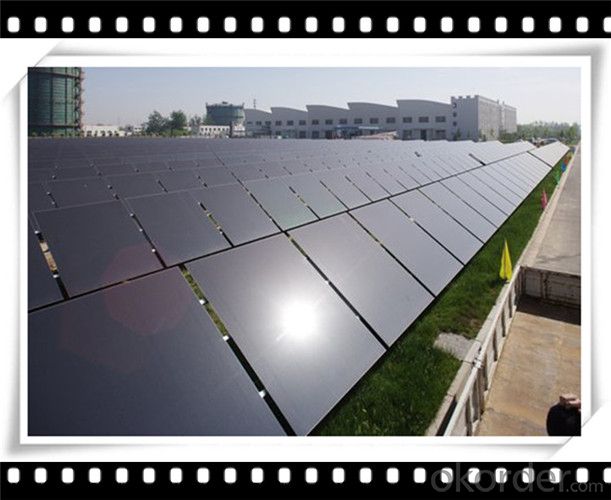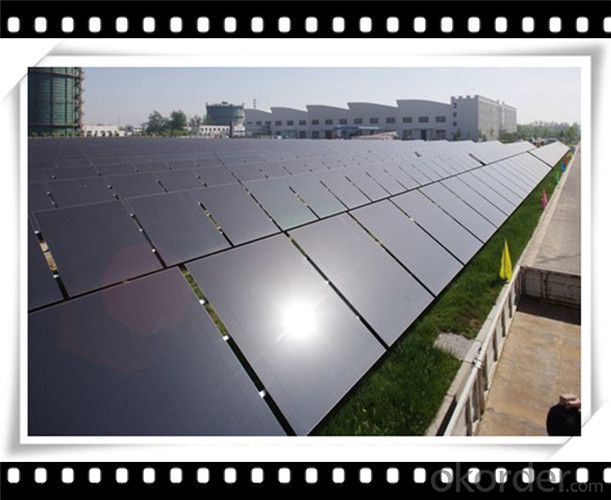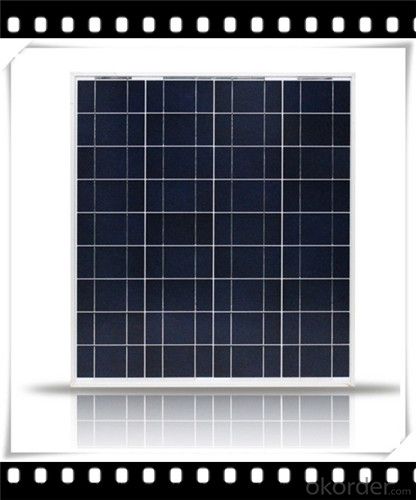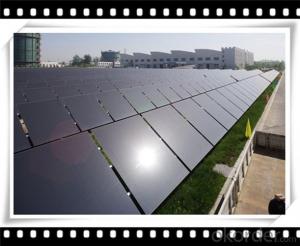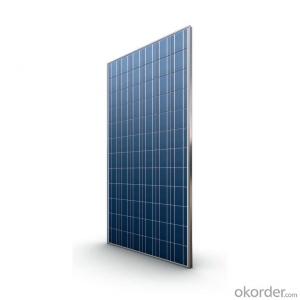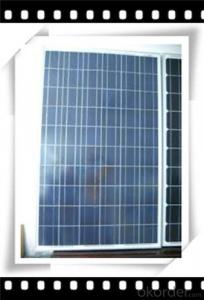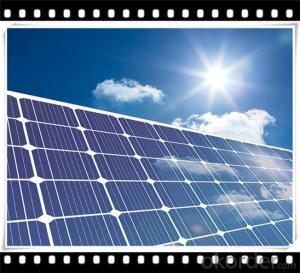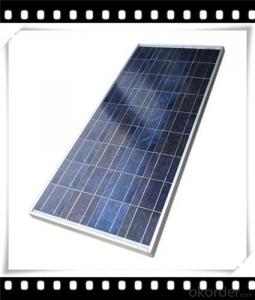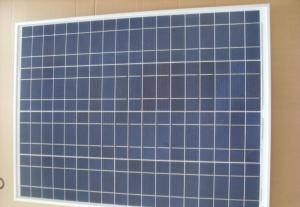80w Poly Solar Panel for Backpacking - Small Solar Panel Manufacturer in China CNBM
- Loading Port:
- Qingdao
- Payment Terms:
- TT OR LC
- Min Order Qty:
- 10 set
- Supply Capability:
- 300000 set/month
OKorder Service Pledge
OKorder Financial Service
You Might Also Like
Polycrystalline Solar Modules
CNBM offers a range of small, medium and large polycrystalline solar modules, designed for a range of requirements.
Specifications:
+/-3% |
Polycrystalline silicon solar cells (156 x 156mm) |
60 (10 x 6) |
1650 x 990 x 40 |
25.5 |
Limits:
Operating Temperature | -40~+85? |
Storage Temperature | -40~+85? |
Maximum System Voltage | 1000 VDC max. |
Hail Impact | Diameter of 28mm with impact speed |
Temperature and Coefficients:
NOCT | 48C+/-2? |
Voltage temperature coefficient (%/K) | -0.35 |
Current temperature coefficient (%/K) | 0.05 |
Power temperature coefficient (%/K) | -0.45 |
Characteristics:
Model: | SGM-200P | SGM-210P | SGM-220P |
Max-power voltage Vmp (V) | 29.2 | 29.4 | 29.41 |
Max-power current Imp (A) | 6.85 | 7.14 | 7.48 |
Open-circuit voltage Voc (V) | 36.5 | 36.69 | 36.9 |
Short-Circuit Current Isc (A) | 7.28 | 7.6 | 7.93 |
Max-power Pm(W) | 200 | 210 | 220 |
Model: | SGM-230P |
Max-power voltage Vmp (V) | 29.8 |
Max-power current Imp (A) | 7.72 |
Open-circuit voltage Voc (V) | 37.31 |
Short-Circuit Current Isc (A) | 8.19 |
Max-power Pm(W) | 230 |
STC: Irradiance 1000W/m2, module temperature 25?, AM-=1.5
Poly Crystalline Solar Panels Specifications Range
Maximum Power (Pm) | Dimension | Weight | Operating Voltage (Vmp) | Operating Current (Imp) | Open Circuit Voltage (Voc) | Short Circuit Current (Isc) |
0.45W | 140x80x10mm | 0.08kg | 3.3V | 150mA | 4.6V | 160mA |
1.0W | 162x140x10mm | 0.16kg | 7.5V | 150mA | 10.3V | 160mA |
4.5W | 269x251x23mm | 0.8kg | 16.5V | 0.27A | 20.5V | 0.3A |
10W | 420.1×268.9×22.6mm | 1.92kg | 17.5V | 0.58A | 20.5V | 0.6A |
20W | 425x502x50mm | 3.0kg | 16.8V | 1.19A | 21.0V | 1.29A |
30W | 593x502x22.6mm | 3.9kg | 16.8V | 1.78A | 21.0V | 1.94A |
40W | 655x537x50mm | 5.75kg | 17.3V | 2.31A | 22.1V | 2.54A |
50W | 839x537x50mm | 6.0kg | 17.5V | 2.9A | 21.8V | 3.17A |
65W | 1111x502x50mm | 7.2kg | 17.6V | 3.69A | 22.1V | 3.99A |
80W | 1204x537x50mm | 7.7kg | 17.6V | 4.55A | 22.1V | 4.8A |
- Q: How will i construct solar panel?
- For powering a something that works on DC, like a gate opener, Elaine is right, and in some cases only ONE bigger cell is sufficient due to battery storage; however if the appliance is 20v AC, then an inverter is needed also. MOST of Elaine's answer is good, but a few corrections are needed: Plywood - use EXTERIOR grade only, and even then it can warp; chipboard or waferboard is preferable as it does NOT warp, BUT is not available most places in 3/8, /2 nominal, (5/32) is usually the thinnest available, and it is heavier than plywood. DO NOT use particle board. Superglue - NO, it dries too fast to be useful, in most cases. Wires - For a single cell OK, but for larger panels the best wire is tabbing wire, (which is flat,) which is available from all commercial solar cell dealers. Be very careful soldering this to the cells, as unless you buy the expensive flexible cells, they are easily damaged; I suggest also getting flux pens with liquid flux. Diode - Necessary, but needs to be large enough to handle voltage and current. Usually 25v and 5-30 amps,, one per panel. Plexiglas - OK, but NOT as long lasting as glass; best glass is the special solar glass which is designed to pass almost all of the proper light frequencies, but IS expensive, and usually needs to be specially ordered since most glass stores do not stock it. Double panes work well with the outer pane glass and the inner plexiglas, (to protect the cell if glass broken,) IF where might get damage, such as 'ground' mounting. AND Frame kits are available for larger panels, but IF you make your own, a good table router is a great advantage. Inverter - IF used for 20v AC appliances you MUST have an inverter capable of handling the load, and the best ones are modified sine, or true sine, wave types, and even the best are less than 50% efficient. Note that they will last longer if NOT used at more than 2/3 capacity.
- Q: solar panel capacity, how do it work
- You can find a lot on the Internet about how solar panels work. See the links below. I'm not sure how you define capacity. Solar panels are made up of many solar cells. Each cell is capable of generating a low DC voltage while delivering a small current, Several cells are connected in series, making strings to develop the required voltage. Then many of these strings are connected in parallel, so the panel can deliver a usable current. Then the panels are connected in series and/or parallel to deliver a usable voltage and current. My panels are rated at 24 volts. 20 panels are connected in series to develop 480 volts. This is sent to an inverter, which converts the 480 volts DC to 20 volts AC
- Q: Hi. I need to build a solar panel for a project. it should be able to light a 60 watt light bulb. also, it should be about 3x3 ft if it is 50% efficient. if anyone knows any websites or can help me, please answer! thanks.
- Making your own photovoltaic (solar electric) panel is a nontrivial matter if you want to get 60 watts out of it. If this is a science fair project, there are some possible paths that I'd suggest: ) Make your own cupric oxide panel. With just one square foot, you can harvest perhaps 0.5 mW in bright sun - enough to power a solar calculator; -or- 2) Buy a panel to light your 60 watt bulb. You could probably get away with a panel that is 6 square feet, but would use a car headlight as the lamp. If you wanted to light a regular household bulb, you would need electronics to step up the voltage, and you would lose a sizeable fraction of the energy just in the conversion. -or- 3) Buy broken solar cell pieces, or individual solar cells, and solder them together into your own panel. This is a LOT of trouble, and is a finicky process to get working and keep working. And it may not end up being cheaper than buying a ready-made panel. But you can claim that you made it! By the way, crystalline silicon panels are in the ballpark of 5% efficient, and a 3' x 3' one would produce in the neighborhood of 20 watts.
- Q: Can solar panels be installed on a concert venue or entertainment facility?
- Yes, solar panels can be installed on a concert venue or entertainment facility. In fact, many venues are increasingly adopting solar energy as a sustainable and cost-effective solution. Solar panels can be installed on rooftops, parking lots, or open spaces around the venue to generate clean and renewable electricity. This not only helps to reduce the environmental impact but also saves on energy costs in the long run.
- Q: Are there any limitations to the lifespan of solar panels?
- Yes, there are limitations to the lifespan of solar panels. While solar panels are designed to be durable and long-lasting, they do have a finite lifespan. The average lifespan of solar panels is typically around 25-30 years. However, environmental factors, such as extreme weather conditions, can affect their performance and longevity. Over time, solar panels may experience degradation, reducing their efficiency and power output. Additionally, technological advancements may render older solar panel models outdated or less efficient. Despite these limitations, proper maintenance and regular cleaning can help extend the lifespan of solar panels.
- Q: On how to connect a solar panel to a battery and then to a lightbulb,the project is offgrid..
- Hi Igor, this is a very simplified version of the system I'm implementing in my shed. I used a guide found on an Answers! member's website, you may find what you're looking for there. Check out the sources section.
- Q: I was hearing that we need silver as a medal for the creation of solar panels, is this true? How much silver would be needed to make one solar panel? (if this is true)
- Some research has shown that small amounts of silver can improve the efficiency of solar panels. But this appears to be in the research stage and applies to the the thin film solar cells. Some solar panels makes use silver as the wiring in kind of a screen printing process, but you don't need to use silver, you can use copper or aluminum using different techniques instead. Generally the metal used is in small amounts and not a majority of the cost of the solar panel.
- Q: Can solar panels be used in areas with high levels of volcanic activity?
- Yes, solar panels can be used in areas with high levels of volcanic activity. Volcanic activity does not directly affect the functionality of solar panels as long as they are installed safely. However, it is important to consider additional factors such as ash fallout, potential acid rain, and the need for regular cleaning and maintenance due to the volcanic environment.
- Q: Can solar panels be installed on a school or educational institution?
- Yes, solar panels can be installed on a school or educational institution. In fact, many schools around the world are increasingly adopting solar energy systems as a sustainable and cost-effective solution to meet their energy needs. Installing solar panels on educational institutions not only helps reduce their carbon footprint but also serves as an educational tool, allowing students to learn about renewable energy and environmental conservation firsthand.
- Q: i need to know wat the parts of a solar panel are.
- A solar panel is just a collection of solar cells all wired up in parallel and series to provide a useful voltage. Typical solar cells only provide half a volt, maybe less, so usually you put 2 of them together to get a 6v solar panel or 24 of them to get a 2v panel. Solar cells are made in various ways, the most popular are silicon solar cells which are made with a chunk of silicon with a P-N junction in the middle and contacts on either side. When a photon of light comes in, the energy of the photon is converted to electrical energy. Individually, photons contain a tiny amount of energy, but when you have a solar cell in the sunlight, billions and billions of photons hitting it constantly create a useful amount of electrical energy. Solar panels are incredibly simple!
Send your message to us
80w Poly Solar Panel for Backpacking - Small Solar Panel Manufacturer in China CNBM
- Loading Port:
- Qingdao
- Payment Terms:
- TT OR LC
- Min Order Qty:
- 10 set
- Supply Capability:
- 300000 set/month
OKorder Service Pledge
OKorder Financial Service
Similar products
Hot products
Hot Searches
Related keywords



